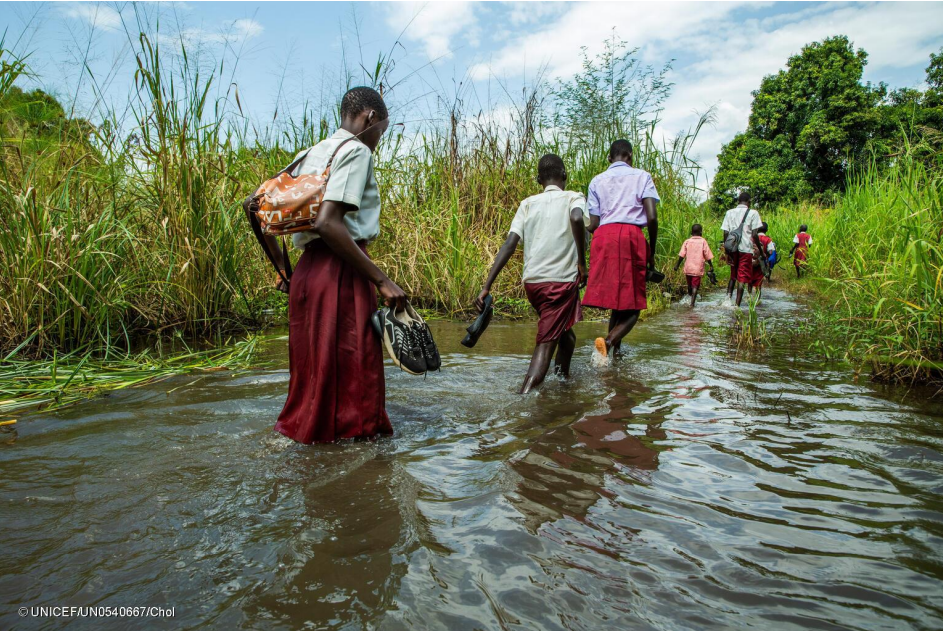
Education: a powerhouse for driving climate ambition
In preparation for COP29, the Geneva Global Hub for
Education in Emergencies (EiE Hub) shares the following key messages:
What the data says
- – A staggering 400 million students globally have experienced school closures
from extreme weather since 2022. - -Between 2016 and 2023, around 62.1 million children were displaced within
their countries due to weather-related disasters.ii Climate change
disproportionately impacts boys and girls who are displaced or affected by
conflicts, violence and other humanitarian crises. - -The loss of school infrastructure is alarming: estimates indicate that the
Education sector experiences financial losses of US$4 billion annually due to
cyclones alone. - -With only about half of national curricula worldwide mentioning climate change,
and usually with minimal depth, this represents a significant missed opportunity
to raise awareness and drive climate action for mitigation and adaptation. - -Climate shocks hinder teachers’ ability to perform, and they are not sufficiently
equipped or supported to teach climate matters effectively. - -Less than half of Nationally Determined Contributions (NDCs) are child- or
youth-sensitive. - -Only 2.4 per cent of climate finance from major multilateral funds is currently
directed towards projects with children as primary beneficiaries in addressing
climate vulnerability and enhancing resilience.
What are the solutions?
- -Recognise the critical impact on – and role of – Education in
addressing the climate crisis
- -Integrate Education for children and youth, including in emergencies, into all
UNFCCC processes (including COP29 and COP30), emphasising the essential
role of children and youth in advancing climate resilience, adaptation and
mitigation, and addressing loss and damage from climate-induced disasters. - -Issue a collective request to the IPCC to have a greater focus in its future
assessments on the disproportionate impacts of climate change on children and
youth, including Education. - -Call on the IPCC to include Education among sectors being considered under
the theme of “Impacts and Risks, including (i) Economic and Non-economic
Losses and Damages and (ii) Compounding and Cascading” for its 2027 Special
Report on Climate Change and Cities. - -Sign and implement ‘The Declaration on the common agenda for education and
climate change adopted at COP28’. - -Building on the Declaration on the common agenda for education and climate
change, include children and youth’s needs such as Education in Long-Term
strategies, NDCs, National Adaptation Plans (NAPs), national strategies for
disaster risk reduction and other relevant plans, such as at city level. - -Build on the Declaration on the common agenda for education and climate change, and strengthen the resilience of education systems, including through the endorsement and implementation of the Comprehensive School Safety Framework.
Promote actions to increase climate finance for Education, including in humanitarian settings
- -For less than US$20 per student, policymakers can adapt and minimise learning losses. It is urgent that climate funds expedite and simplify their approval and disbursement processes to increase funding for adaptation and mitigation projects focusing on sectors that enhance resilience and co-benefits for vulnerable communities, such as Education, including in humanitarian settings.
- -Call on the UNFCCC to prepare and release a “loss and damage finance gap
report” that will present the financing gap that the newly institutionalised “Fund
for responding to Loss and Damage” will close, particularly in sectors directly
concerned by climate-related loss and damage, including Education in climate
emergencies and disasters. - -Include Education in climate-induced emergency and disaster situations as one
of the core result areas for investment of the “Fund for responding to Loss and
Damage”, along with child-specific indicators in monitoring and evaluation
frameworks, as appropriate. - -Ensure that the New Collective Quantified Goal on Climate Finance (NCQG)
incorporates children’s right to a quality, safe, inclusive Education, as a guiding
principle in line with preambular paragraph 11 of the Paris Agreement, the
Convention on the Rights of the Child and General Comment No.26.
Include children and youth in decision making – and support their role as agents of change
- -Enhance the inclusion, participation, and representation of children and youth in
global and national climate policy-making and action, including via the support to
or establishment of child-friendly mechanisms for their engagement in climate
policymaking, including NDCs, NAPs and other climate plans. - -Embed green skills and climate education into national curricula across all
levels, including in emergencies, to empower children, youth and teachers as
agents of change who can build resilience, take climate action, and drive a just
transition to a sustainable green economy.
- -Support the Action for Climate Empowerment (ACE) agenda, including the
uptake and dissemination of the guidelines and good practices on education and
empowerment, with special considerations for gender equality and inclusion of
persons with disabilities (activity C.2 of the ACE Glasgow Work Programme),
including in updates to NDCs and NAPs.
Together we can drive climate ambition, adapt and minimise learning
losses for all children and youth.
Faced with the under-prioritisation and underfunding of EiE, and given the
magnitude of the challenge, the 52 EiE Hub members come together to form a
strong alliance of diverse states, UN agencies, organisations, funds and civil society
to step up visibility, political and operational commitment, and funding for EiE.
To see the full list of members, please visit: https://eiehub.org/about/members
